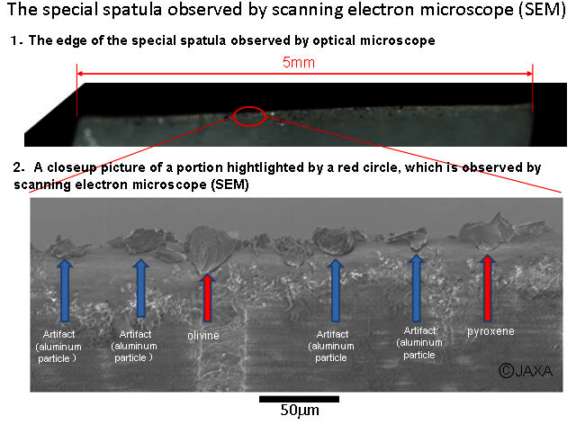Emily Lakdawalla • Nov 17, 2010
A little more information on the Hayabusa samples from Itokawa
Since I posted an update Monday about JAXA confirming extraterrestrial samples in the Hayabusa sample return capsule, JAXA has posted an English-language version of their press release, which contains a bit more information. The text of the release is short but they also had a few slide-like images that had much more detail. To make this information a bit more search-engine friendly, I'm going to copy it here, with some editing and commentary.
JAXA writes: "Based on the results of the scanning electron microscope (SEM) observations and analyses of samples that were collected with a special spatula from sample catcher compartment 'A,' about 1,500 grains were identified as rocky particles, and most of them were judged to be of extraterrestrial origin, and definitely from Asteroid Itokawa. The Hayabusa sampler container consists of 2 compartments that are called Sample Catcher A and B." Got that? We are talking about only one of two sample containers that were within the sample return capsule.
In a related figure, JAXA explains the criteria we they used to conclude that most of the particles from sample catcher compartment 'A' are from asteroid Itokawa.
First, they identified the mineral grains found within sample capsule A to be predominantly olivine, with some pyroxene, plagioclase, and iron sulfide. While all of these are common rock-forming minerals on Earth as well as in space, the assemblage found in the Hayabusa sample container is not that common among Earth rocks, and they are much richer in iron relative to magnesium than typical Earth rocks.
Second, the composition of Itokawa's surface measured using Hayabusa's remote sensing instruments (red dot) agrees well with the measured compositions of the grains found in the capsule, suggesting that the particles found within the capsule likely originated on Itokawa.
Third, none of the grains within Sample Catcher A were found to be igneous rocks like the dacite found near the launch site at Sakurajima, nor were any grains found to be similar to the quartz, clays, and carbonates that occur at the landing site in Woomera.
JAXA continues: "Their size is mostly less than 10 micrometers, and handling these grains requires very special skills and techniques. JAXA is developing the necessary handling techniques and preparing the associated equipment for the initial (but more detailed) analyses of these ultra-minute particles."
They included a photo of the special Teflon (fluorine resin) spatula that they used to scrape out sample chamber A.

And here are some closeup photos. I had these photos in my post on Monday but they make much more sense with the English-language labels!

That's pretty much it. However, I suspect that most of you are asking an obvious question: all of this is about one of two canisters within the sample return capsule. What about the other one -- what about sample catcher B?
This requires a little explanation, and I hope I have this correct. (This was discussed on the Hayabusa science results thread on unmannedspaceflight.com, where a user who goes by "pandaneko" is helpfully posting a lot of information from Japanese sources. With the help of pandaneko's translations, I can find at least some of these facts in the Google translated text of a Japanese blogger's report on a press briefing held on July 5.) The sample canister is a cylinder with two internal chambers There was an opening in the external cylinder covering 120 of its 360 degrees. When Hayabusa launched, the opening was aligned with sample catcher B -- that is, Hayabusa launched with sample catcher B open. (This guarded against sample return failing utterly if the sample catcher door system failed.) Hayabusa touched down on Itokawa twice. When it touched down the first time, the sample capsule chamber door was still positioned over sample catcher B, as it had been since launch. After the first landing, the door was rotated, shutting off access to sample catcher B and opening access to sample catcher A -- the first time sample catcher A was opened since it had been in the clean room. So sample catcher A was open for the second touchdown.
Since Hayabusa returned the sample capsule to Earth, only sample catcher A has been opened by the science team. It appears that they are taking a great deal of care with their work with sample catcher A, making sure to perfect all of their procedures, from retrieval to analysis, before they try sample catcher B. Sample catcher B was open for the more violent of the two landings, so it may actually contain more material than sample catcher A. However, it is also more likely to contain material that was brought from Earth, since it was open during Hayabusa's launch.
Let’s Go Beyond The Horizon
Every success in space exploration is the result of the community of space enthusiasts, like you, who believe it is important. You can help usher in the next great era of space exploration with your gift today.
Donate Today

 Explore Worlds
Explore Worlds Find Life
Find Life Defend Earth
Defend Earth


